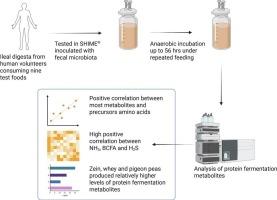Exploring in vitro production of colonic microbial metabolites from diverse protein sources using human ileal digesta
IF 9.8
1区 农林科学
Q1 CHEMISTRY, APPLIED
引用次数: 0
Abstract
We explored the relationship between protein fermentation metabolites and ileal digesta composition, using ileal digesta from ileostomates, who ingested nine different protein sources, incubated in the Simulator of the Human Intestinal Microbial Ecosystem (SHIME®). NH3, short-chain fatty acids, branched-chain fatty acids (BCFA), H2S, tryptophan derivatives, and biogenic amines were measured in proximal and distal colon vessels. The relative changes in most metabolites were positively correlated with their amino acid precursors in ileal digesta. In both colon vessels, the relative change of NH3 was a good predictor for the production of other metabolites. Indole was strongly associated with oxindole, 5-HT, and tryptamine and the sum of Trp metabolites in the distal colon. Per gram ingested protein, zein and whey may produce the highest levels of NH3 and BCFA in the proximal colon and BCFA in the distal colon, whereas whey and pigeon peas may result in the highest levels of H2S.

探索利用人类回肠食糜从不同蛋白质来源体外生产结肠微生物代谢物
研究人员利用在人类肠道微生物生态系统模拟器(SHIME®)中培养的九种不同蛋白质来源的回肠食糜,探讨了蛋白质发酵代谢物与回肠食糜组成之间的关系。测定近端和远端结肠血管中NH3、短链脂肪酸、支链脂肪酸(BCFA)、H2S、色氨酸衍生物和生物胺含量。回肠食糜中大多数代谢物的相对变化与其氨基酸前体呈正相关。在两种结肠血管中,NH3的相对变化可以很好地预测其他代谢物的产生。吲哚与远端结肠中吲哚、5-羟色胺、色胺和色氨酸代谢产物的总量密切相关。每克摄入的蛋白质,玉米蛋白和乳清可能在近端结肠产生最高水平的NH3和BCFA,在远端结肠产生最高水平的BCFA,而乳清和鸽子豆可能产生最高水平的H2S。
本文章由计算机程序翻译,如有差异,请以英文原文为准。
求助全文
约1分钟内获得全文
求助全文
来源期刊

Food Chemistry
工程技术-食品科技
CiteScore
16.30
自引率
10.20%
发文量
3130
审稿时长
122 days
期刊介绍:
Food Chemistry publishes original research papers dealing with the advancement of the chemistry and biochemistry of foods or the analytical methods/ approach used. All papers should focus on the novelty of the research carried out.
 求助内容:
求助内容: 应助结果提醒方式:
应助结果提醒方式:


